Media
Transcript
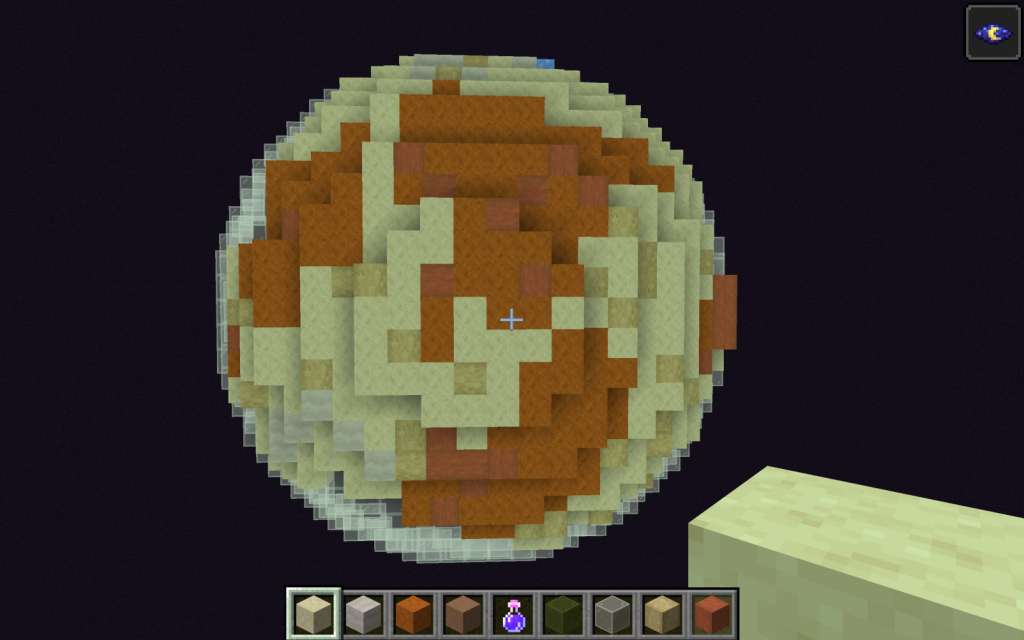
Last weekend we streamed for 36 straight hours during the CosmoQuest Hangout-a-thon 2020. Our goals were to build a scale model of the solar system in Minecraft and to raise money to support CosmoQuest in 2021. I am pleased to share that we brought in about $14,000 and completed all our solar system builds, except for Saturn and Jupiter, which turned out to be much more time consuming than anticipated. We will be keeping our Minecraft server on through at least the U.S. Thanksgiving holiday and will bring you periodic updates. If you would like to join us, please stop by the CosmoQuest Discord server to volunteer.
And now for the news.
Last week, the big story was the touch-and-go sample event, where OSIRIS-REx attempted to collect a sample from our favorite asteroid to hate, Bennu. We all watched live and listened to the team give updates of the procedure as it happened. Then we watched the press conference the next day that talked about what would happen next. And we waited for the weekend to find out just how much sample the spacecraft collected.

It turned out that they collected, well, a lot. When the mission team looked at images of the Touch-And-Go Sample Acquisition Mechanism (TAGSAM), they found that the collector head was overflowing with material. And while they definitely collected more than the minimum 60 grams, they also managed to collect so much material that the mylar flap could not seal shut. It was wedged open by sample, and bits of those rocks we marked were escaping back out into space.
Because Bennu needed to spit more rocks at the universe, apparently.
This overabundance of samples meant that there was no need to return to the surface of Bennu and collect any more rocks. So the decision was made to stow the sample ahead of the scheduled November 2nd date and call that portion of the mission done. As principal investigator Dante Lauretta stated: The abundance of material we collected from Bennu made it possible to expedite our decision to stow. The team is now working around the clock to accelerate the stowage timeline so that we can protect as much of this material as possible for return to Earth.
And accelerate the timeline they did. They announced yesterday that the collector head was successfully placed in the Sample Return Capsule. Then they performed a “backout check”, pulling the TAGSAM arm back out to make sure the collection is secure. Telemetry confirmed that the sample is indeed stowed. Now the team has to perform a couple more commands, and when we have confirmation that everything is nominal and the capsule is sealed, we will let you know.
For now, we wait. And then we wait some more as the sample will not arrive back on Earth until 2023.
While Bennu was the biggest story of the year to a lot of members of our community, to many others, the big story of the week was the Stratospheric Observatory for Infrared Astronomy’s (SOFIA) detection of fresh evidence for water on the Moon.
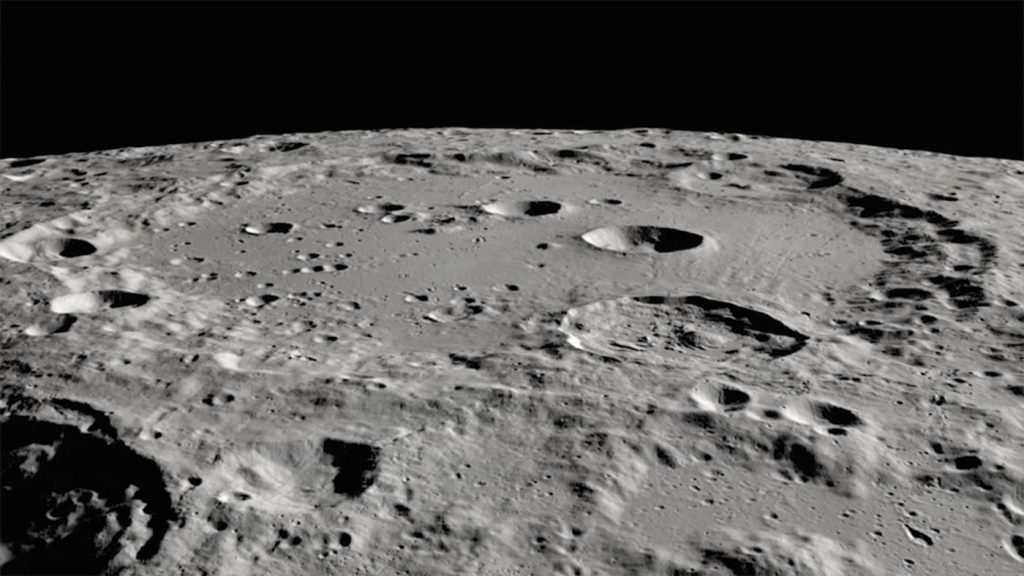
On Monday, NASA hosted a press conference announcing that this infrared-sensitive airborne observatory had detected a molecular transition consistent with water being present in Clavius Crater. Water was detected at the surface in about 1 part in 1000, which means that if you process 1000 thimblefuls of soil, you’d have a bucket of regolith and one thimble of water. A lot of attention was given to this as a lunar resource story, with claims that this water will make it easier for astronauts to survive on the moon.
And, as a lunar resource story, this new water detection has gotten a lot of criticism on Twitter and listservs far and wide.
Put simply, processing regolith to extract that tiny amount of water is energy-intensive and not something we can readily do at the moment. This story also made it sound like we’re dealing with moist soil, with the water just kind of mixed in, and that isn’t the case.
Here is what’s actually going on: There is a long history of making measurements that indicate water either is or could be mixed within the minerals covering much of the lunar surface. These detections have come from neutron detectors on the Lunar Reconnaissance Orbiter (LRO), spectroscopic detections from the Lunar CRater Observation and Sensing Satellite (LCROSS) collision, and from a variety of infrared detections from different missions and telescopes. Up until now, these detections have detected something consistent with the possibility of water but not necessarily water – molecules with hydroxyl, or OH, groups can look like water, and neutron detections just say there is a lot of hydrogen consistent with water.
The SOFIA airborne observatory, however, is one of the rare facilities that can detect a roughly 6-micron spectral line from water, and on a flight to transport the aircraft between two locations, a graduate student, Casey Honnibal, convinced senior researchers to try and detect lunar water at that line. No one really expected the detection was possible, but it turns out Casey, now a postdoc at NASA Goddard, was onto something, and this detection was totally possible. She and the team she was part of observed both Clavius Crater and an area on the equator of the moon and only detected water in the far southern crater.
Now, if you are thinking, “Water shouldn’t exist in sunlit regions on the Moon”, you are absolutely right. This water is mixed in with the minerals in a way that exposes it to the environment of space. It is most likely encapsulated in volcanic glasses or other protective minerals that allow us to see its spectra but that also protects it. This is a common enough phenomenon, and there is a famous diamond that was found on Earth and includes a pocket of water from deep in the planet protected within the crystal structure.
So, to put this in perspective, a grad student pleaded her case and got SOFIA to point at the Moon and look for water. This initial test of her idea was a complete success, showing water in the southern Clavius Crater and not in a region near the equator. This result is consistent with other water detections, and by expanding research into a new molecular transition, gives us even more certainty that what we’re seeing is real. This water is only about one part in 1000, is trapped in minerals, and is thus hard to liberate and not present in large quantities, but it is there.
I can’t wait to see what Honniball does next as she expands her research into lunar water. For now, I have to be satisfied with her paper in Nature Astronomy.
NASA’s rather controversial and overhyped press conference not only shadowed the brilliant work of Honnibal, but also another paper about water on the moon featuring two Planetary Science Institute researchers.
Once again, in the quest for lunar resources, scientists used data from NASA’s Lunar Reconnaissance Orbiter to try and find water ice. They studied shaded areas and concluded that up to 20 percent of the frozen water on the Moon could be in small cold traps scattered over the polar regions. These cold traps are not only shadowed but could be more accessible to lunar rovers.
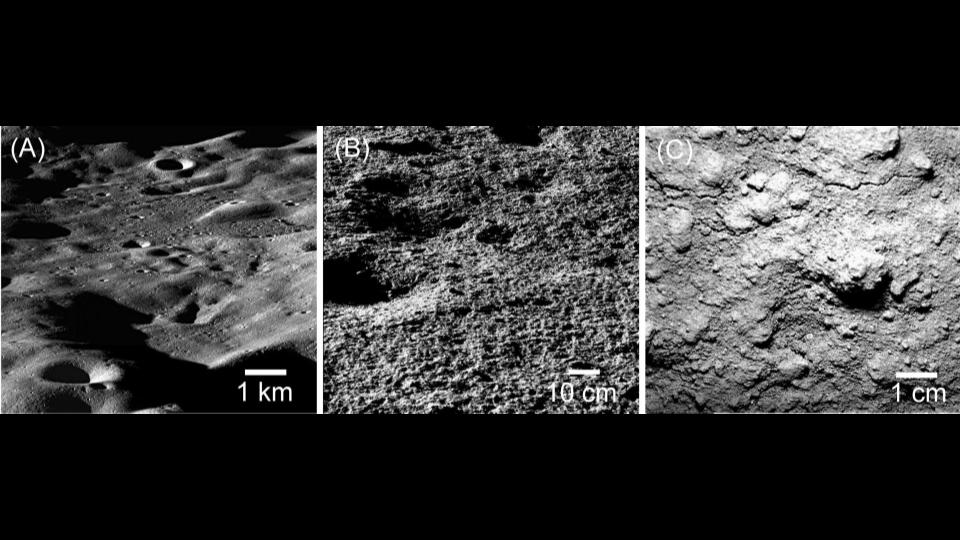
PSI senior scientist Norbert Schörghofer explains: Future lunar rovers may have a hard time driving into a large dark crater with extremely low temperatures. Small cold traps are far more accessible. Approximately 10 to 20% of the permanent cold-trap area for water is found to be contained in these micro cold traps. In terms of numbers, most cold traps are smaller than 1 meter.
Co-author and also a senior scientist at PSI Oded Aharonson goes on to say: The smaller deposits should be more accessible for at least two reasons: the distance to the nearest one from a hypothetical landing site might be shorter, and the deposit would not be surrounded by imposing tall crater rims, but rather much gentler slopes.
A lot of the work here is theoretical since even the LRO cannot give us the spatial resolution to see these micro traps. Instead, the team did a statistical analysis using several extrapolation techniques to determine the potential number of micro traps on the lunar surface.
For example, per the press release: ...the team calculated how the instantaneous shadow in a crater for a given height of the Sun above the horizon is related to the extent of the truly permanent shadow in that crater. They then measured the extent of shadows in thousands of images of the lunar surface for various Sun elevations, and combined the measurements with the geometric factors to estimate the total area in permanent shadow. They also calculated the temperatures of these areas to predict in which one’s ice can accumulate.
And my son thinks geometry is useless.
So while looking for a thimbleful of water in 1000 thimbles full of regolith sounds extremely energy-intensive, driving into a small cold trap with shallow slopes to access a water ice deposit with your lunar rover sounds relatively simple. Both of these studies aid in the quest for lunar resources, and I’m sure there will be more to come as we get closer to the launch of NASA’s Artemis mission.
From the nearby moon, we now jump to the farthest reaches of the outer solar system.
In 2014, Mike Brown and Konstantin Batygin noted the dwarf planets in the outer solar system have a statistically weird orbital distribution that can best be explained by adding a several Earth-mass planet out 12-23 times farther from the Sun than Pluto. All attempts to find this object in existing all-sky surveys have so far failed, and for a while, it has been thought we’d need to wait for the construction at the Rubin Observatory to be completed before it could be found.
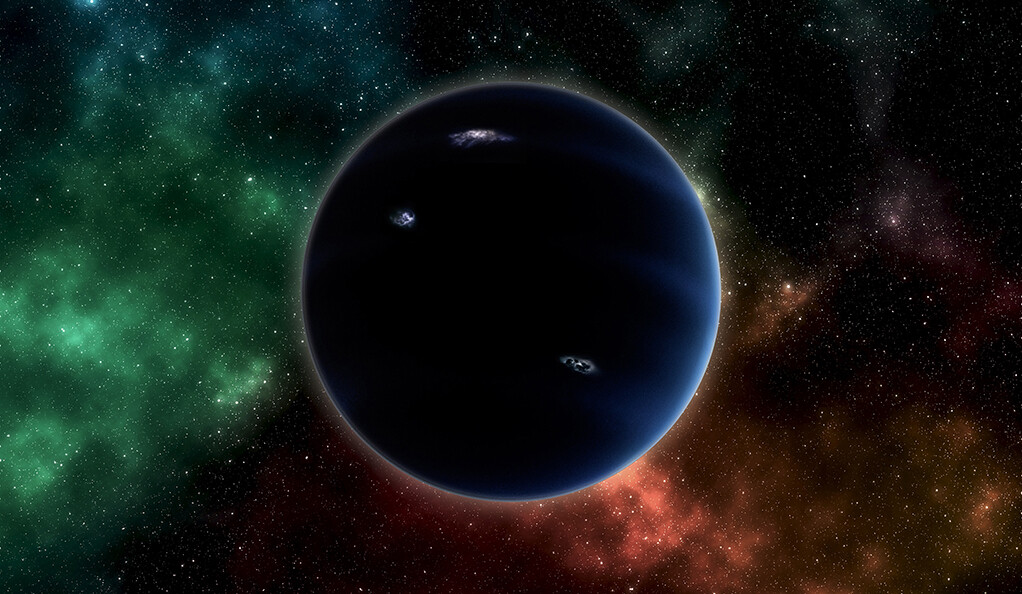
Astronomers aren’t always patient, however, and a team from Yale University – Malena Rice and Gregory Laughlin – decided to see if they could boost the signal and find something using NASA’s Transiting Exoplanet Survey Satellite (TESS) data. This orbiting observatory is taking repeated images of local stars to look for potential transiting planets. While this data isn’t designed to look for a potential Planet 9, it turns out it is still super useful.
Rice and Laughlin created software that allows them to stack the TESS images to mimic the effect of TESS tracking the sky at the rate that a Planet 9 would be moving instead of at the rate the stars are moving. In the resulting images, star trails dominate, but in a few images, faint specks also emerge, appearing unmoving, and marking the potential location of an unknown outer solar system object or a known object; they find those, too, and that confirms their software works.
So far, this team has found seventeen potential objects in the outer solar system, and they are currently performing ground-based follow-up observations. It could be that they have found Planet 9 in this group. I really hope the reopening of so many observatories allows them to come out with their result soon.
One of my favorite parts of this is that Rice is a graduate student, once again showing us that great discoveries can come from people of all ages.
Last week, I talked about some of the upcoming US-based asteroid missions that are in the works. One of those is a mission to asteroid Psyche 16. This week, a new paper was presented at the virtual meeting of the American Astronomical Society’s Division for Planetary Sciences that gives us a clearer picture of the target asteroid.

As I stated last week, Psyche is a dense and mostly metallic asteroid that scientists think is the leftover core of a failed planet in the region of the asteroid belt. In this study, researchers observed Psyche in the ultraviolet at both sides of its rotation to get a different look at the surface. The results were intriguing.
Southwest Research Institute planetary scientist and lead author Dr. Tracy Becker said: We were able to identify for the first time on any asteroid what we think are iron oxide ultraviolet absorption bands. This is an indication that oxidation is happening on the asteroid, which could be a result of the solar wind hitting the surface.
While the observation confirms the presence of iron on Psyche’s surface, it is not a confirmation of the full composition. It turns out that even a small amount of weathered iron could dominate ultraviolet observations. However, the asteroid seemed to become increasingly reflective at deeper UV wavelengths. Becker noted that: This could be indicative of it being exposed in space for so long. This type of UV brightening is often attributed to space weathering.
More studies need to be done, and that mission to Psyche is still exciting to me. I hope it is the core of a failed planet. We can potentially learn so much from one small-ish body in our solar system.
Our final story of the day is just kind of pretty.
As galaxies plunge into galaxy clusters, they force their way through gas and dust and often gravitationally interact with other systems. All these interactions leave galaxies looking a bit ratty, and one class of irregular systems have been dubbed jellyfish galaxies because their leading edge is compressed, and they end up trailing star-forming regions behind them in what look like arms.
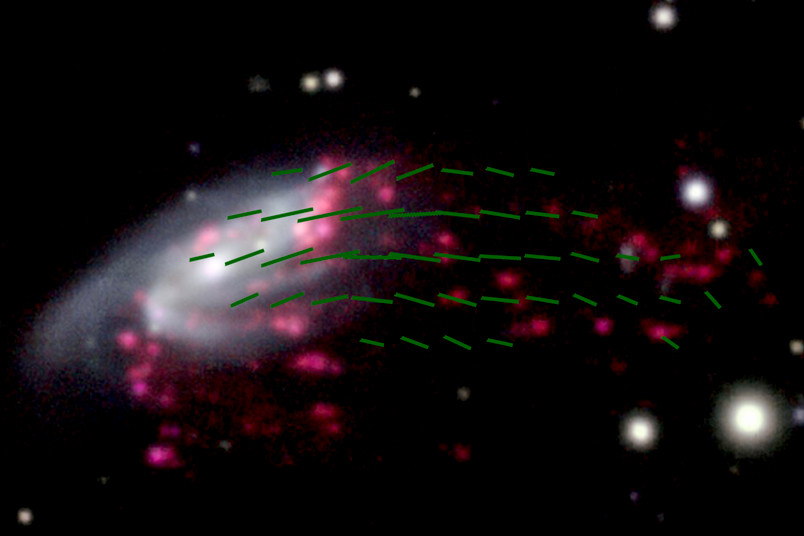
In new research appearing in Nature Astronomy and led by Ancla Muller, astronomers take a deep look at the jellyfish galaxy JO 206 to determine if magnetic fields play a role in knitting together these structures. The answer is yes! They were able to determine that the galaxy’s strong magnetic field is aligned with the arms. According to co-author Christoph Pfrommer: While the jellyfish galaxy flies through the galaxy cluster, its magnetic field wraps around the galaxy like a mantle and is further amplified and smoothed by the high galaxy speed and cooling effects.
According to the press release: JO206 falls at high speed into the center of the galaxy cluster, so that the magnetic fields interact and hot winds from the medium between the galaxies lead to accumulations of plasma. A percentage of the plasma condenses on the outer layers of the gas tail, where it mixes with the remaining matter. This would provide enough material for star formation. It should be fascinating to see whether this picture can be confirmed by further measurements on other objects.
I can’t wait to see their future jellyfish in space measurements. This is the kind of science and amusement needed in 2020.
Learn More
OSIRIS-REx Spacecraft Goes for Early Stow of Asteroid Sample
SOFIA Discovers Water on Sunlit Surface of Moon
- NASA press release
- DLR press release
- “Molecular Water Detected on the Sunlit Moon by SOFIA,” C. I. Honniball et al., 2020 Oct. 26, Nature Astronomy
Small Water Ice Reservoirs Dot the Lunar Surface
- PSI press release
- “Micro Cold Traps on the Moon,” P. O. Hayne, O. Aharonson & N. Schörghofer, 2020 Oct. 26, Nature Astronomy (preprint on arxiv.org)
Lighting a Path to Find Planet Nine
Study Offers More Complete View of Massive Asteroid Psyche
- SwRI press release
- “HST UV Observations of Asteroid (16) Psyche,” Tracy M. Becker et al., 2020 Oct. 26, Planetary Science Journal
The Magnetic Fields of a Jellyfish Galaxy
- Ruhr-Universität Bochum press release
- “Highly Ordered Magnetic Fields in the Tail of the Jellyfish Galaxy JO206,” Ancla Müller et al., 2020 Oct. 26, Nature Astronomy (preprint on arxiv.org)
Credits
Written by Pamela Gay and Beth Johnson
Hosted by Pamela Gay and Beth Johnson
Audio and Video Editing by Ally Pelphrey
Content Editing by Beth Johnson
Intro and Outro music by Kevin MacLeod, https://incompetech.com/music/


 We record most shows live, on Twitch. Follow us today to get alerts when we go live.
We record most shows live, on Twitch. Follow us today to get alerts when we go live.